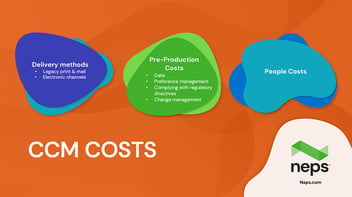What Is Transactional Communication? Navigating the Word Soup of CCM
The final product of a good CCM program is usually a few pages of black text printed on white paper, folded and inserted into a standard-size window envelope. On a surface level, it doesn’t seem that complicated.
Notice :
Neps and Venture Solutions are now a singular CCM powerhouse.
© NEPS.com
However, the people who work with CCM programs know that couldn’t be further from the truth. Mixing government policies, incorporating variable content full of PII and PHI data, and keeping up with unending change management and lightning speed turn-times makes this, to put it simply, complicated work.
These complications would be easier to understand if there was a common language within the CCM industry—and there is one, of course. But a few twists can add a layer of unnecessary confusion to a CCM discussion.
We’ll identify some areas of confusion and offer clarity, so we can help you better navigate the CCM buzzword bingo and make your work life a little easier.
Three Synonymous Terms
When discussing documents such as invoices, statements, or notification letters, you’ll most likely hear one of three terms being applied:

Customer Communication Management
This has become the de facto term for financial transactional information between a company and its customers—invoices, monthly statements, explanation of benefits, tax documents, etc.—and communications that include sensitive and legal topics—payment past-due letters, mortgage default notices, denial of coverage letters, mortgage warnings and notices, etc.
Given the broad topics a company needs for its enterprise communication program, the term "customer communication management" is the most appropriate, all-encompassing moniker.
Transactional Communication
Perhaps the second most common term used for enterprise communication programs, “transactional communication” gives only half of the picture. From welcome letters to highly sensitive, mandated notices, communications can go well beyond “transactional” and touch upon highly consequential, legal, and emotional topics.

Critical Communication
This term is the other side of the CCM coin that “transactional communications” didn’t touch upon; it focuses on the sensitive communications while missing the transactional component. Additionally, the term loses some of its precision in the digital world, as modern, digitally transformed companies would say their marketing communication—particularly its electronic channels—is equally “critical.”
Essentially, these three terms are synonymous and there is nothing wrong with using any of them. Simply keep in mind that Customer Communications Management is the most inclusive, comprehensive term.
Additional Terms Often Encountered in CCM Work
Omni-Channel
During the 90s and 00s, CCM providers used multiple channels to deliver communications. The key channels were print and mail and email while online viewing and SMS text started to take hold, as well. These multiple channels were “siloed”—they operated separately, with their own composition engines, work groups, deployment mechanisms, and reporting apparatus. Coordinating them into a single, efficient workflow was a challenging approach often called multi-channel delivery.
However, as technology evolved, it became possible to produce and deploy any channel from a common workflow—making it an “omni-channel” solution. Companies such as Quadient, for example, developed channel agnostic software to process data and compose pages.

Data Processing
For CCM, data processing refers to specific tasks that are required to successfully produce customer communications. In our digital world, there are few things done without data processing.
Given that most medium-to-large companies have several legacy information systems, many of which feed data into customer communications, there is a need for data processing expertise to consolidate the many types of input coming from these systems. There’s also often a need for “on the fly” list editing to remove records that should not be sent out.
Additionally, like the analog print and mail channel, the new electronic output channels of email, SMS, ISPs, and telecoms have rigorous requirements around what they will accept for output. For example, the USPS have strict standards around address hygiene, mover updates, and IMb coding. It’s within the data processing steps that these requirements are programmed and processed.

Page Composition
This workflow step defines CCM production—where all business rules, processed data, and graphic design elements come together to form the pages that the consumer reads. And, as discussed in the previous section, the composition must conform to the exacting requirements of the delivery channel used, whether that be print, email, SMS text, or online viewing.
Given CCM communications contain significant amounts of variable data, each page for each record is essentially one-to-one communication. For example, if a monthly mortgage statement has one million records, the output will contain one million unique pages. This workflow step must also happen at lightning speed to deliver the service level agreements to which CCM programs must adhere.
These heavy demands mean a CCM program can only succeed with:
-
Up-to-date software that can perform the required tasks
-
Expertise on input data and how it influences page composition
-
Deep understanding of delivery entities (USPS, ISPs, telecoms) to ensure compliance
-
Automated capabilities with human monitoring and interaction, as needed

CCM Platform
Though ubiquitous, each industry has a slightly different definition of what the word "platform" means to them. In the CCM industry, a platform is a solution that combines proprietary programming, software products, real-time information, and a user interface built specifically to handle the early stages of CCM production.

More specifically, a CCM platform:
- Integrates software solutions that process input data, compose variable content pages, and output a file to mail, email, and SMS text providers
- Monitors how the tasks are proceeding via dashboard, keeps the workflow moving between steps, and provides alerts and reports when there are problems
- Provides online self-service engagement with business rule programming and template content at any time, from any location
- Creates files of each document in its original form for archiving and future reference
This allows the early steps of production to be fully automated, without which the aggressive deadline and accuracy requirements of CCM could never be met.
For additional information on a CCM platform, please see our blog post, What Is a CCM Platform?

Business Continuity vs. Disaster Recovery
Put simply, business continuity events refer to a short-term interruption of services such as weather interruptions from snow or ice. These can shut down a facility for a few days, often because production workers cannot safely commute. As soon as the weather improves, production starts back up. While the interruption is brief, it impacts the quick service level agreements common in CCM production. Even when a facility shuts down for only two or three days, a backup option must be activated to comply with deadlines.
Disaster recovery, on the other hand, is commonly used to describe facility shutdowns that may go on for a week or longer. This may arise due to a catastrophic weather event such as a hurricane, tornado, or fire. Physical space may need to be re-built, new equipment acquired, material re-assembled, and new data servers configured. As such, activating a redundant site during a longer recovery period becomes a much more complicated endeavor. A top-tier service provider will be able to provide both types of response
Relationship Marketing
As the first section of the blog shows, enterprise communication is typically divided into two specialties: transactional and marketing communication.
However, at Neps, working with some of the most forward-thinking companies in America, we’ve noticed the rise of a third type, a hybrid of the two: relationship marketing.
It combines the non-selling aspect of transactional communication with the personal touch of marketing communication. Some topics common in relationship communication include important policy changes, such as diversity initiatives, leadership changes, or updates on civic engagements. Such communication often strengthens relationships with current customers and fosters ongoing loyalty.
Digital advancements and quality improvements from service providers such as Neps have given rise to the relationship marketing approach. New capabilities in electronic delivery such as email and SMS text, as well as inkjet high-speed printer improvements to attain the color fidelity of lithographic printing, can now deliver omni-channel output on par with a company that specializes in marketing communication.




